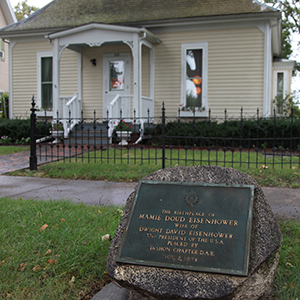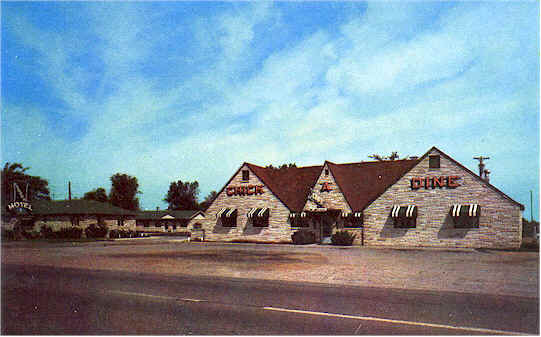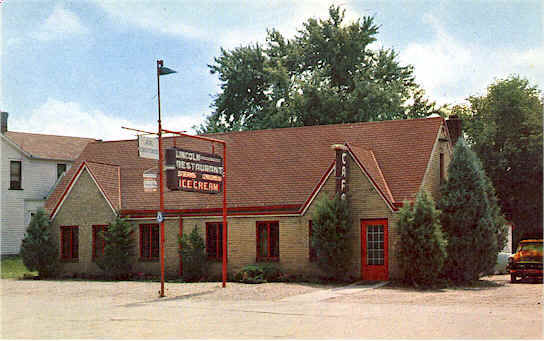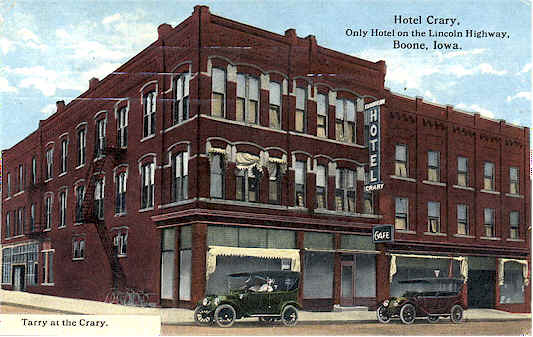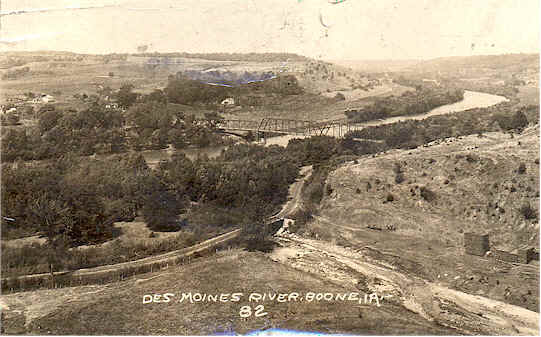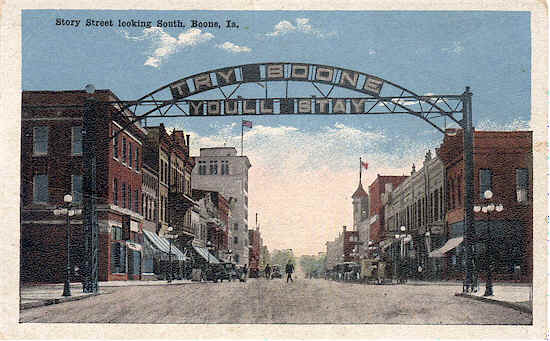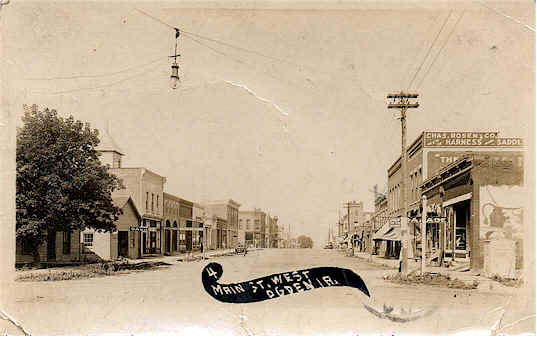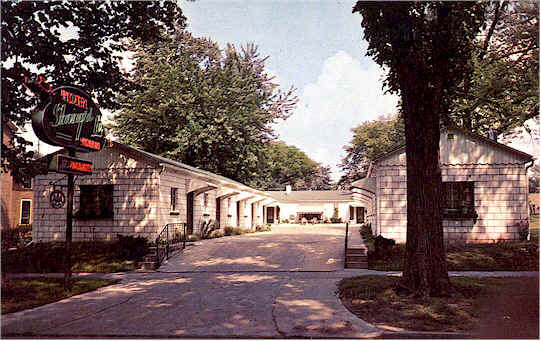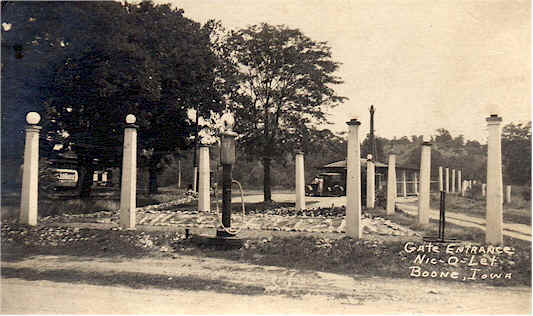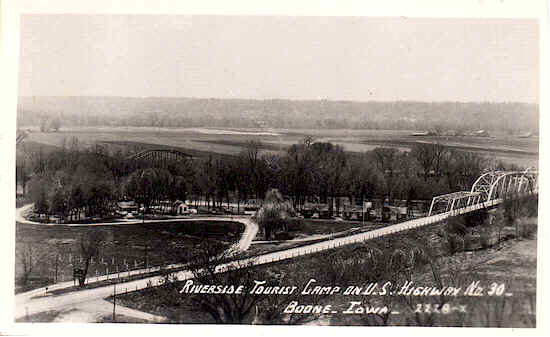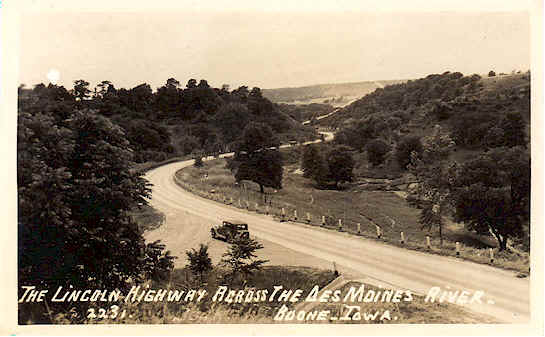Boone
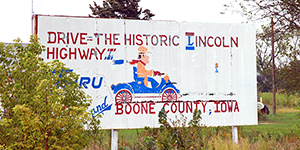 Boone County
Boone County
The United States Government, in hopes of settling the West, tried to remove Indians from the land. In 1832, conflict broke out between government forces and Sauk leader, Black Hawk. He attempted to retake a village in Illinois and 3 months later was defeated at a battle in Wisconsin. Following the Black Hawk War, the Black Hawk Purchase opened up Wisconsin, Illinois, and Iowa for settlement.
Just after the Purchase, Lt. Col. Stephen Kearney led three companies of the first regiment of the US Dragoons up the Des Moines River from Old Fort Des Moines to southern Minnesota. Their mission was to assess the Indian situation in Iowa and explore it for further settlement. On June 23, 1835, Capt. Nathan Boone (youngest son of Daniel Boone and commander of H Company) camped near Mineral Ridge in what is now Boone County.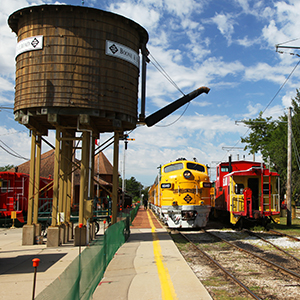
Twelve years later, the county was organized and named for Capt. Boone. For two years it remained part of Polk County, but in 1849, the residents wanted their own county jurisdiction in which to vote, pay taxes, and do business. According to Iowa Law, the sheriff was to order the election of county officers; but there was no sheriff. In May 1849, a judge appointed a sheriff who then divided the county into townships. In 1860, Iowa law transferred the power of duties from judges to a Board of Supervisors.
Settlers poured in after the Civil War and the railroad developed In Ogden and Boone. Coal mining flourished in the towns of Madrid, Boone, Moingona, Ogden, Fraser, and many other towns. As the coal deposits disappeared, so did some of the towns -while others remained steadfast.
Boone
In 1851, Boonesboro was determined to be the county seat. In 1865, John Insley Blair established the railroad town, Montana, just 1 ½ miles to the east of Boonesboro. There had been a dispute over where the station and rail line should be located. By 1867, Montana had 300 buildings and its population rivaled that of Boonesboro. In 1871, the Montana residents filed a petition to change the name to “Boone”. By 1887, Boone and Boonesboro had grown together and Boonesboro was annexed by Boone. Today, you can see the two distinct downtowns of Boone and Boonesboro (west Boone) and the county offices are still located in the Boonesboro portion of the community.
The community rallied around as a rail line was to be removed and raised funds to save it. Today it is operated as the Boone and Scenic Valley Railroad which travels through the picturesque Des Moines River Valley and crosses the 156-foot Bass Point Creek High Bridge. It is possible to see wild turkey, deer, eagles, and a great view of the valley. www.bsvrr.com
The Kate Shelley High Bridge is the highest double track railroad bridge in the US. It is 3 miles west of Boone. It was built in 1901 and is 185 feet above the Des Moines River Valley and is 2,685 feet long. In 1912, it was named for Kate Shelley who crawled across the tracks to warn an oncoming passenger train that a bridge had washed out on a stormy night in 1881.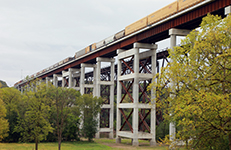
The Boone Historical Society and Museums oversees the Kate Shelley Park in Moingona, Hickory Grove School and Batton Chapel Church (along the Lincoln Highway), the Mamie Doud Eisenhower birthplace, and the museum in the former Champion Memorial Masonic Temple.
The Boone Speedway is a dirt track for sanctioned modifieds, stock cars, hobby stocks, and non-sanctioned dwarf cars. The grandstand holds 5,000 spectators. www.raceboone.com
Seven Oaks, just to the west of Boone on Highway 30 (1086 222nd Dr), offers snow skiing, snowboarding, snow tubing, paintball, canoeing, kayaking, tube floating, camping, hiking, and mountain biking. (515-432-9457.)
Every two years, the Farm Progress Show is held at the Central Iowa Expo Center, a 100-acre outdoor expositions site at the intersection of Highway30 and 17. The Farm Progress show offers 500 farm-related exhibitors and is the largest outdoor farm logo event. There are field demonstrations and manufacturers and suppliers. The event averages 240,000 attendees.
John Blair, an official with the railroad, platted the town in 1866 and named it for his friend and fellow railroad magnate, William Butler Ogden. William Ogden was the first president of the Galena and Chicago Union railroad and the Chicago and Northwestern Railroad. The town of Ogden, like Boone, was a railroad town.
Beaver
Beaver was either named for Mr. Bever, a citizen of Cedar Rapids, or for a nearby stream that was home to many beaver. Today Beaver’s only business is a grain elevator. The town is home to 48 people.
Boone County and the Lincoln Highway
Boone County was known in the early days for their coal mines and that is what attracted the railroad to the area. When the Lincoln Highway was looking for the best route in Iowa, it often followed the railroad. It is hard to separate the history of the two modes of transportation and they will always have that connection. Today, Boone celebrates the Railroad with their Boone and Scenic Valley Train rides and Museums. The original Lincoln Highway is marked as the Lincoln Highway Heritage Byway as it winds through the downtown. One will notice the 7-story building downtown, as most Iowa county seats have 2-3 story buildings. It is evident that Boone saw great economic success in its early coal mining years.
The Lincoln Highway then travels to the main street in Ogden. It took many years for the route to be completely paved and Ogden did not pave it until 1929. The crew doing the paving had moved on down the line and before the pavement had dried and cured an appropriate amount of time, someone walked across the road- leaving his footprints forever in the road. The footprints were filled in with a different consistency of patch, so although they were filled in, they were still visible. Today the entire pavement is wearing down from traffic and they are less visible. Although if a visitor knows where to look for the footprints, they may still be seen. A photo of the footprints is on file in the Iowa Department of Transportation Archives. Today, the city of Ogden hopes to remove the footprints and preserve them in a small, nearby park in the downtown area.
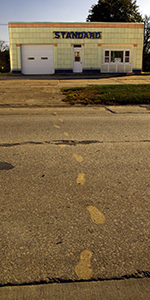
A section of these footprints was cut out of the road and are displayed in Downtown Ogden. The street has been resurfaced.
Ogden was the first meeting site when the Lincoln Highway Association was re-formed in 1992.
Other Towns in Boone County
Berkley
This town was first called Somersville and laid out in 1883. The Minneapolis and St Louis Railroad ran through town. Today the population is 32.
Boxholm
Boxholm was platted in 1900 and the first postmaster, John B, Anderson, named it for a town in Sweden since most of the residents were from Sweden. The Newton and Northwestern Railroad, later known as the Fort Dodge, Des Moines, and Southern railroad ran through town.
Fraser
The Fraser Coal Company laid out the town in 1893. The rail line through town was soon electrified and interurban cars were used. Autos eventually gained popularity over trains for passenger movement, but trains carrying freight continued. Today the High Trestle Bridge is nearby. The High Trestle is 1/2 mile long and 17 stories high over the Des Moines River Valley. Trail Head Depot is located at Fraser and the trail runs 20 miles to Ankeny. (See Madrid for more information on the High Trestle Trail.)
Logansport
The town is unincorporated.
Luther
In 1883, Clark Luther built a storehouse on the town’s site and one source says the town was named for him. Another source says it was named for Martin Luther, a German religious reformer. Although a post office was in town since 1884, Luther was not platted until 1893. This is a farming community, like many Iowa towns, and their grain and livestock was shipped from the town when the Boone line of the Chicago, Milwaukee and St. Paul Railroad ran through it.
Mackey
The town was once called Mackey’s Grove and was never platted. It had a post office, church, and a few businesses. Today all that remains is a little church, cemetery, and a one-room school house. www.facebook.com/pages/Mackey-Iowa/169072159811691
Madrid
Madrid is the oldest town in the county. The first settler was Charles W. Gaston of Pennsylvania who arrived in 1846. It was named Swede Point, for the many Swedish immigrants who settled here. Legend has it that Gaston was the executor of his mother-in-law’s estate and he had an argument with his brother-in-laws. Out of resentment, he changed the name of the town to Madrid. He had a Spaniard in his employ who talked often of Madrid, the capitol of his country. Gaston had contempt for the Spaniard, his country, and his capitol. So to get even with his Swedish “brothers”, Gaston took the name Swede Point away and gave it the name Madrid. Madrid is the oldest continuously inhabited Swedish settlement west of the Mississippi River.
Madrid was a coal mining town in 1910 and Italians and Croatians immigrated to the area to work in the mines. Today, Madrid has a statue of a coal miner on Highway 17 and the Madrid Museum has a life-size replica of a portion of a coal mine and a scale model of one of the area coal mines. The Madrid Museum consists of 4 separate, but connected, buildings at 109 W 2nd St (515-795-3249.)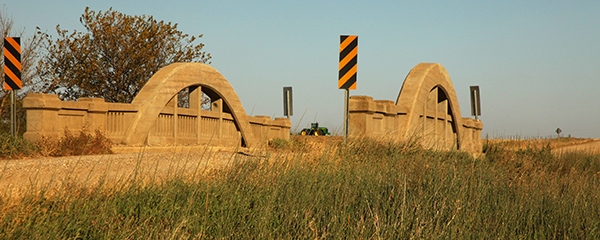
Several locations where you can enjoy the outdoors include the Iowa Arboretum, just outside of Madrid, at 1875 Peach St, www.iowaarboreteum.org (515-795-3216) and the Ledges State Park at 1515 P Ave (515-432-1852).
Another very popular site, with a much photographed bridge, is the High Trestle Trail. The Trail is a 10-foot wide concrete trail for bikes, walkers, runners, and skaters. There is a parallel 10-15 foot surface trail for horseback riding. Parking for the Trestle Trail is at Dolander Park at Highway 17. The Flat Tire Lounge is on the trail (304 S Madison, 515-795-4174) and Brown’s Pizza and Saddles BBQ Bistro are close by. You can rent 2-wheel bikes, tandem bikes, recumbent bikes, kid’s bikes, and wheelchairs for 4 hour periods at www.trailsiderentals.com, (515-230-6712). They also have group pricing!
Snus Hill Winery is located at 2183 320th St (515-795-3535) and the Tiger Bowl (bowling alley) at 205 Annex Rd (515-795-2695). The Hindu Temple and Cultural Center is at 33916 155th Lane, www.iowatemple.org (515-792-2635) www.madridiowa.com.
Moingona
Coal was abundant in the area and the Chicago Northwestern railroad established a station and organized the town here in 1866. The town prospered until the coal ran out and the railroad straightened out their line. The rail no longer ran through town. C.E. Vail named the town, but why it has this name is not clear. The name might have come from the Indian word Mi-Ko-Nang which means “road”. When the French pronounced it, it sounded like Moingona. Or another idea is that is named for the Moingoana Indians, for whom the Des Moines River is named. It is conjectured that means “loon”.
Of importance, Moingona is the home to Kate Shelley who as a young woman became a heroine on 7/6/1881 when she crawled across a high bridge to warn an oncoming passenger train of a bridge washout during a violent storm. She saved the lives of many railroad men and passengers. The Boone Historical Society Museum has a Kate Shelley display and more information of her heroism and bravery.
Pilot Mound
The town was laid out in 1881 and a post office with the same name existed prior to the town. It was named for the large mound located in the area. The mound, as it was so visible, served as a meeting place. An Indian battle occurred here between the Sac and Fox under Chief Keokuk and the Sioux under Chief Wamsapasia. The Sac and Fox won the battle and remains of many of the Indians killed in battle were found in this region.
Pilot Mound has the second highest point in Boone County and on a clear day, you can see several towns. It is also home to Twister Hill, where parts of the the movie “Twister” was filmed. The town has a sense of humor as a sign outside of town on 130th St. indicates the entrance to town is via “the next 5 exits”. www.pilotmoundiowa.com.
Sheldahal (partial)
This town lies in 3 counties- Polk, Story, and Boone. It was named for the owner of the land and today has a population of 319.
Woodward (partial)
Woodward lied in both Dallas County and Boone County. It was first called Colton, but changed by the railroad. One idea is that the name came from Woodward Gardens in California and another idea is that it was intended to be named for Frank Woodworth, a popular ticket agent at the station, but to his disappointment they changed it to Woodward.
Vanished Towns
Angus
Originally this was called Coal Town. In 1885, it was the largest coal mining in Iowa and had a population of 3,000-5,000 people. A strike, declining coal reserves, closing of the mine, the bank panic, and the re-routing of the Minneapolis and St. Louis rail line doomed the town.
Jordan
Jordan was originally called Midway. The name Jordan came from the Jordan River in Palestine. The town was never platted or incorporated. It continued in existence until June 13, 1976 when an F5 tornado ripped through town and destroyed everything in town. A video of the tornado can be seen with this link. www.youtube.com/watch?v=LKhIMFIT-VE
Zenorsville
In 1880, there were 3 coal mines in operation here. By 1914, the community was gone.

